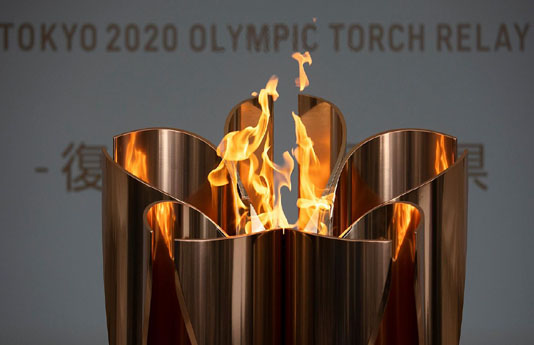FUKUSHIMA, Japan, March 25, 2021 (BSS/AFP) – The Tokyo Olympics torch
relay kicked off Thursday, a year late and without spectators, heralding a
major step towards the start of the coronavirus-delayed Games on July 23.
The rose-gold, cherry blossom-shaped Olympic torch was lit at the J-
Village sports complex in Fukushima, which served as a base for operations
responding to the 2011 nuclear disaster.
Speaking at the launch ceremony, Tokyo 2020 chief Seiko Hashimoto said she
hoped the Olympic flame would serve as “a ray of light at the end of the
darkness”.
“This little flame never lost hope and it waited for this day like a
cherry blossom bud just about to bloom,” she added.
The nationwide relay, like the Olympics themselves, will be vastly
different from previous editions, with spectators banned from cheering and
kept away from the launch and first leg over coronavirus concerns.
Fans will be able to line the route and clap as the flame traverses the
country, borne by 10,000 runners and passing through all 47 prefectures
before arriving at Tokyo’s National Stadium for the July 23 opening ceremony.
But parts of the relay could be suspended if too many spectators gather in
one place, and masks are mandatory for onlookers.
Organisers were making final preparations for the relay last year when the
coronavirus prompted the historic decision to postpone the Games, as sport
around the world ground to a halt.
A year on, the pandemic is still in full swing despite vaccine rollouts,
and organisers are battling public scepticism in Japan about holding the
Olympics.
With overseas spectators barred from the Games and limits likely on
domestic fans, the relay is seen as a vital opportunity to build enthusiasm.
“The torch relay is intended to communicate that the Olympic Games will
take place,” Tokyo 2020 CEO Toshiro Muto told reporters this week.
“It makes people feel that the Games are about to start — that’s the
nature of the torch relay.”
– ‘Recovery Olympics’ –
The relay launch will put the spotlight back on the region affected by the
2011 quake, tsunami and nuclear disaster.
The Games were initially billed as the “Recovery Olympics”, showcasing
reconstruction in the northeastern region of Tohoku that was devastated by
the quake, tsunami and nuclear meltdown a decade ago.
The pandemic has overshadowed that message, but Fukushima’s torchbearers
hope the relay will still shine a positive light on the area.
“From afar, Fukushima might look like a place where time has stood still,”
Hanae Nojiri, a TV reporter who will be one of the torchbearers, told AFP
before the relay.
“But when people see the spectators lining the roads and the passion of
the runners, I think they’ll update their image of the place.”
The relay will pass through some towns that remain only partially open to
the public, as decontamination continues in radiation-affected areas.
And some residents are ambivalent about the Olympics.
“It’s annoying if we’re going to be used for some kind of propaganda” for
the Games, Yoshiaki Suda, mayor of Onagawa town in Miyagi region, said
recently.
Others are more keen, with Fukushima governor Masao Uchibori saying
Thursday the torch would “connect people all over Japan”.
“The reconstruction Games are very special to people living in Fukushima.
We want to show the energy of today’s Fukushima to the world.”
The relay will take a circuitous route, first heading south to the islands
of Okinawa before reversing course for the northern region of Hokkaido and
finally back to Tokyo.
The flame will pass landmarks including Mount Fuji and the Hiroshima City
Peace Memorial Park. However, there are still challenges ahead for
organisers.
Several dozen torchbearers have dropped out, citing issues including
scheduling conflicts and concerns about the coronavirus.
Officials from one region have warned they might cancel the relay there if
virus countermeasures aren’t improved.
But organisers are hopeful the event will offer respite after a difficult
year.
“People are feeling cut off from each other at this time,” Hashimoto said
Wednesday.
“These 10,000 runners can connect with people everywhere.”



